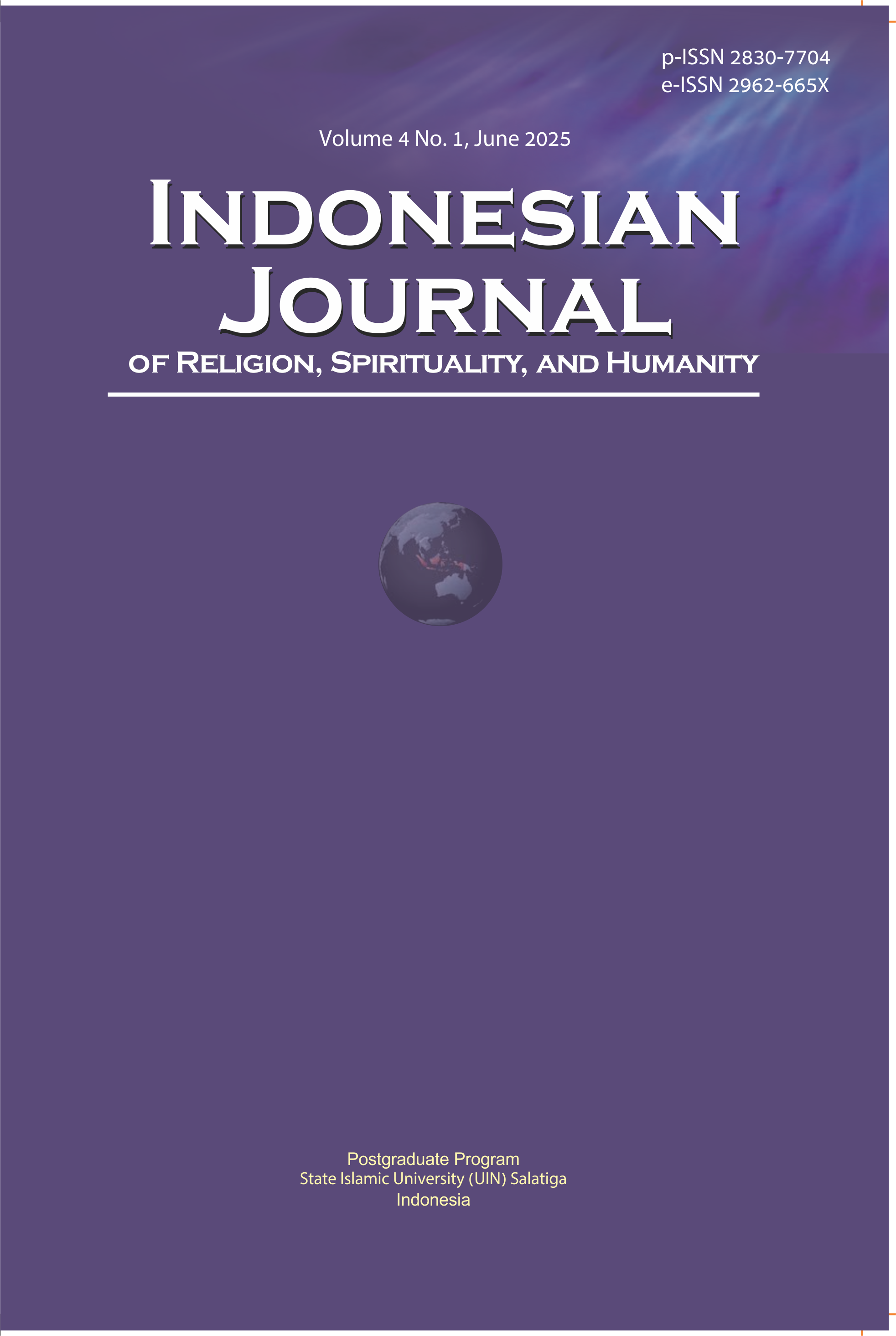The ethics of ḥayā’ in contemporary Middle Eastern Salafism: meaning, forms and functions of modesty
DOI:
https://doi.org/10.18326/ijoresh.v4i1.1-24Keywords:
Islamic ethics, Hayā’, Moral responsibility, Modesty, Shame, SalafismAbstract
This article examines the concept of ḥayāʼ (modesty) in contemporary Salafi discourse, a topic that is often overlooked in academic studies, reducing it to a narrow understanding of shame. In relation to classical Islamic ethics present ḥayāʼ as a multidimensional virtue encompassing dignity, self-restraint, and moral responsibility, this study fills the gap by analysing how modern Salafi thinkers redefine ḥayāʼ as a preventive ethical framework central to Islamic piety and behaviour. The research aims at identifying the meanings, forms, and functions of ḥayāʼ as exemplified in five major Salafi texts from Egypt, Jordan, Lebanon, and Saudi Arabia. It employs a tripartite approach consisting of historical contextualization, close textual analysis, and ethical interpretation to establish contemporary Salafi modesty discourse within the broader Islamic moral tradition. The findings show that Salafi scholars combine classical ḥadith-based definitions with determined Sufi ethical insights to present ḥayāʼ as a comprehensive moral force. They emphasise its role in fostering God-consciousness, discouraging immoral behaviour, and nurturing disciplined conduct, thereby reinforcing both individual virtue and social order. The study demonstrates that Salafi ethics of modesty reflect a hybrid character that remains committed to tradition while adapting to contemporary Muslim contexts. As a result, this research contributes to a more nuanced understanding of Islamic ethics, particularly in clarifying the expanding role of ḥayāʼ in the Salafi discourse. It also encourages further research to assess how other Islamic schools align or differ from Salafism in their ethical views on ḥayāʼ and related virtues.
References
Abu-Lughod, L. (2009). Modesty Discourses: Overview. In: Encyclopedia of Women & Islamic Cultures. Edited by Suad Joseph.
Abu-Lughod, L. (1986). Veiled Sentiments: Honor and Poetry in a Bedouin Society. Berkeley: University of California Press.
Albugami, F. and Bhawuk, D. (2023). Defining the Construct of ḥayā': A Multi-method Approach. In: Cultural Perspectives on Shame: Unities and Diversities. Edited By Cecilea Mun, New York: Routledge, pp. 80-110.
Al-Bukhārī, M b. I. (1955). al-Adab al-mufrad. Edited by Muḥammad Fu’ād ‘Abd al-Bāqī. Cairo: al-Maktaba al-Salafiyya,.
Al-Bukhārī, M. b. I. (2002). al-Jāmi‘ al-ṣaḥīḥ. Damascus: Dār Ibn Kathīr.
Al-Hilālī, S. (1988). al-Ḥayā’ fī ḍaw’ al-Qur’ān al-karīm wa-l-aḥādīth al-ṣaḥīḥa. Dammam: Maktabat Ibn al-Jawzī.
Al-Muqaddam, M. b. I. (1993). al-Ḥayā’ khuluq al-Islām. Cairo: Dār al-Ḥaramayn.
Al-Muqaddam, M. b. I. (2006). Fiqh al-ḥayā’. Alexandria: al-Dār al-‘Ālamiyya li-l-Nashr wa-l-Tawzī‘.
Al-Ruwayshid, A. b. R.. (n.d), al-Ḥayā’ qarīn al-īmān. Riyad: Dār al-Waṭan li-l-Nashr.
Al-Tibrīzī, A. (1810). Mishcat-Ul-Masabih or Collection of the Most Authentic Traditions Regarding the Actions and Sayings of Muhammed. Calcutta: Hindoostanee Press.
Andaryani, F. & Fitriani (2022). Introvert self disclosure and Al-Haya in Islamic perspective: Study of takhrij and syarah hadith. Journal of Takhrij Al-Hadith, 1(2), 24-34. https://doi.org/10.15575/jth.v1i2.22863
Anjum, O. (2010). Sufism without Mysticism? Ibn Qayyim al-Ǧawziyyah's Objectives in Madāriǧ al-Sālikīn. Oriente Moderno, 90, 161-188. https://www.jstor.org/stable/23253753
Aruc. (2023). Arab Union Catalogue. https://www.aruc.org
Benkheira, M. H. (2008). Hammam, nudité et ordre moral dans l'islam médiéval (II). Revue de l'histoire des religions, 225, 319-371. https://doi.org/10.4000/rhr.5783
Bori, C. & Holtzman, L. (2010). A Scholar in the Shadow. Oriente Moderno, 90: 13-44.
Bowen, D. L. (1997). Abortion, Islam, and the 1994 Cairo Population Conference. International Journal of Middle East, 29 (2), 161-184. https://doi.org/10.1017/S002074380006445X
Duderija, A. (2023). Overcoming the Conceptual link between Patriarchal Honor and Female Modesty Laws in the Islamic Interpretive Tradition. In: Shame, Modesty, and Honor in Islam. Edited by Ayang Utriza Yakin, Adis Duderija & An Van Raemdonck. London: Bloomsbury, pp. 37-52.
El Guindi, F. (1981). Veiling Infitah with Muslim Ethic: Egypt’s Contemporary Islamic Movement. Social Problems, 28 (4), 465-485. https://doi.org/10.2307/800058
El Guindi, F. (1999). Veil: Modesty, Privacy, and Resistance. Oxford: Berg Publishers.
Foehr-Janssens, Y., Naef, S. & Schlaepfer, A. (2015). Voile, corps et pudeur : approches historiques et anthropologiques. Genève: Labor et Fides.
Ghazi, S. (2024). Unpacking the Conceptualizations of Hayâ. In: The Handbook of Cultural Linguistics. Edited by A. Korangy. Singapore : Springer, pp. 465–472.
Haenni, P. (2003). Morales hors normes : composer librement avec la pudeur féminine dans l'Égypte d'aujourd'hui. Maghreb Machrek, 175, 95-112.
Hayes, J. (2023). Configurations of Shame from Ancient Greece to Medieval Islam. In: Cultural Perspectives on Shame: Unities and Diversities. Edited By Cecilea Mun. New York: Routledge, pp. 60-79.
Hoffman-Ladd, V. J. (1987). Polemics on the Modesty and Segregation of Women in Contemporary Egypt. International Journal of Middle East Studies, 19 (1), 23-50. https://doi.org/10.1017/S0020743800031640
Hossain, R. S. and Jahan, R. (2013). Sultana's Dream: And Selections from The Secluded Ones. New York : The Feminist Press at CUNY.
Ibn al-Bāghandī, M. (1977). Musnad ‘Umar ibn ‘Abd al-‘Azīz. Multan: al-Maktaba al-Fārūqiyya.
Ibn Qayyim al-Jawziyya. (n. d). Madārij al-sālikīn bayna manāzil iyyāka na‘bud wa-iyyāka nasta‘īn. Beirut: Dār al-Kutub al-‘Ilmiyya.
Katz, M. H. (2014). Shame (Ḥayāʾ) as an Affective Disposition in Islamic Legal Thought. Journal of Law, Religion and State, 3 ( 2), 139–169. https://doi.org/10.1163/22124810-00302003
Krawietz, B. (2010). Transgressive Creativity in the Making. Ibn Qayyim al-Gawziyyah's Reframing within Hanbali Legal Methodology. Oriente Moderno, 90, 47-66. https://www.jstor.org/stable/23253747
Krawietz, B. (1991). Die Ḥurma : Schariatrechtlicher Schutz vor Eingriffen in die körperliche Unversehrtheit nach arabischen Fatwas des 20. Jahrhunderts. Berlin : Duncker & Humblot.
Le Guen-Formenti, L. (2015). De la mise en scène pudique comme expression d’une morale musulmane sur Youtube. Tic & société 9 (1-2), 1-30. https://doi.org/10.4000/ticetsociete.1824
Mahmood, S. (2005). Politics of Piety : The Islamic Revival and the Feminist Subject. Princeton: Princeton University Press.
Mahmood, S. (2001). Feminist Theory, Embodiment, and the Docile Agent. Cultural Anthropology, 16 (2), 202–236.
Marino, D. (2023). Shame and Murû'a in Medieval Islam. In: Shame, Modesty, and Honor in Islam. Edited by Ayang Utriza Yakin, Adis Duderija & An Van Raemdonck. London: Bloomsbury, pp. 23-36.
McLarney, E. (2017). A Soft Force: Women in Egypt's Islamic Awakening. Princeton: Princeton University Press.
Meneley, A. (1996). Tournaments of Value: Sociability and Hierarchy in a Yemeni Town. Toronto: University of Toronto Press.
Naamane-Guessous, S. (1992). Au-delà de toute pudeur : la sexualité féminine au Maroc. Casablanca: Eddif.
Raslān, M. S. (n.d). al-Ḥayā’ min Allāh wa-min al-khalq wa-min al-nafs shīmat al-kirām wa-fiṭra insāniyya sawiyya.
Sawai, R. P., Jaafar, N. Noah, S. M. & Krauss, S. (2020). Inculcating the Sense of Modesty (Al-Haya’) in Youth from the Perspectives of the Quran and Sunnah. Maʿālim al-Qurʾān wa al-Sunnah, 16 (2),16-30. https://doi.org/10.33102/jmqs.v16i2.230
Wahbī, ‘A. b. Ḥ. (2011). Tadhkīr al-aḥyā’ bi-khuluq al-ḥayā’. Beirut: Jam‘iyyat al-Sirāj al-Munīr al-Islāmiyya.
Zeghidour, S. (1992). La retenue islamique. In: La pudeur: la réserve et le troube. Edited by Claude Habib. Paris: Les Editions Autrement, pp. 103-105.
Downloads
Published
How to Cite
Issue
Section
License
Copyright (c) 2025 Belhaj Abdessamad

This work is licensed under a Creative Commons Attribution-ShareAlike 4.0 International License.
Copyright
Authors who publish with Indonesian Journal of Religion, Spirituality, and Humanity agree to the following terms:
- Authors retain copyright and grant the journal right of first publication with the work simultaneously licensed under a Creative Commons Attribution License (CC BY-SA 4.0)that allows others to share the work with an acknowledgement of the work's authorship and initial publication in this journal.
- Authors have the right to enter into separate, additional contractual arrangements for the non-exclusive distribution of the journal's published version of the work (e.g., post it to an institutional repository or publish it in a book), with an acknowledgment of its initial publication in this journal.
- Authors are permitted and encouraged to post their work online (e.g., in institutional repositories or on their website) prior to and during the submission process, as it can lead to productive exchanges, as well as earlier and greater citation of published work.
Licensing
This work is licensed under a Creative Commons Attribution-ShareAlike 4.0 International License.








